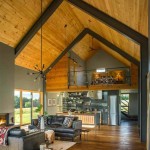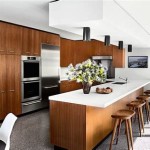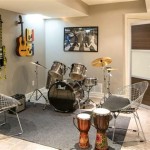How To Decorate an Open Living Room and Kitchen Together
Open-plan living, which combines the living room and kitchen into a single, unified space, has become a prevalent design trend. This layout fosters social interaction, encourages a sense of spaciousness, and allows for a seamless flow between different functional areas. However, decorating an open living room and kitchen together presents unique challenges. It requires careful planning and execution to create a cohesive and aesthetically pleasing environment that effectively balances functionality and style. The key is to establish a visual connection while subtly defining the boundaries of each zone.
The primary objective in decorating an open living room and kitchen is to achieve a harmonious design that reflects a unified aesthetic. This entails selecting a consistent color palette, employing similar design elements, and strategically using furniture to create a cohesive flow. The following sections will explore key strategies for successfully decorating an open living room and kitchen, ensuring a visually appealing and functional space.
Establishing a Cohesive Color Palette
Color plays a crucial role in establishing visual unity in an open-plan space. A well-chosen color palette can create a sense of harmony and flow between the living room and kitchen areas. It is advisable to select a limited number of colors, typically two or three main hues, and use them consistently throughout both spaces. These colors should complement each other and reflect the desired overall aesthetic, whether it's a warm and inviting atmosphere or a cool and modern vibe.
Neutral colors, such as white, gray, beige, and cream, are excellent choices for open-plan spaces as they provide a versatile backdrop that can be easily accented with pops of color. These neutral tones create a sense of spaciousness and allow for flexibility in incorporating different design styles and furniture pieces. They also serve as a unifying element, seamlessly connecting the living room and kitchen areas.
Accent colors can be introduced through accessories, artwork, textiles, and even kitchenware. These pops of color can add visual interest and personality to the space without overwhelming the overall design. Consider using accent colors in the same family or complementary colors to create a balanced and harmonious look. For example, if the main color palette is gray and white, accent colors like blue, yellow, or green can be incorporated to add vibrancy and depth.
The color of the cabinetry in the kitchen should also be taken into consideration when selecting the overall color palette. If the cabinetry is a bold color, it may be necessary to tone down the colors in the living room to avoid creating a visually jarring effect. Conversely, if the cabinetry is neutral, you may have more freedom to experiment with bolder colors in the living room area. The key is to create a visual balance and ensure that the colors in both spaces work together harmoniously.
Furthermore, consider the lighting in both spaces when selecting colors. Natural light can significantly impact how colors appear, so it's important to test paint samples in both the living room and kitchen at different times of the day. Artificial lighting can also affect color perception, so choose light bulbs with the appropriate color temperature to complement the chosen palette.
Defining Zones with Furniture Arrangement and Rugs
While maintaining a cohesive aesthetic is essential, it's equally important to define the distinct zones within the open-plan space. Furniture arrangement and the strategic use of rugs can effectively delineate the living room and kitchen areas without constructing physical barriers. These techniques help to create visual separation while maintaining the open and airy feel of the space.
In the living room area, a large area rug can anchor the seating arrangement and create a defined space for relaxation and conversation. The rug should be large enough to accommodate all the major furniture pieces, such as the sofa, chairs, and coffee table. This helps to visually group the furniture and create a cohesive seating area.
The placement of the sofa can also help to define the boundary between the living room and kitchen. Position the sofa so that its back faces the kitchen area, creating a visual barrier that separates the two spaces. This arrangement allows for a clear distinction between the living and cooking areas while maintaining an open flow.
In the kitchen, a kitchen island can serve as a natural divider between the cooking area and the living room. The island can also provide additional counter space, storage, and seating, making it a versatile and functional element in the open-plan space. The island's design should complement the overall aesthetic of the kitchen and living room, creating a seamless transition between the two areas.
Consider using different flooring materials to further define the zones. For example, you could use hardwood flooring in the living room and tile flooring in the kitchen. This creates a subtle visual distinction between the two spaces while also offering practical benefits, such as easy cleaning in the kitchen and warmth and comfort in the living room.
Additionally, carefully consider the height of furniture pieces. Lower furniture in the living area can help to create a sense of spaciousness and openness, while taller kitchen cabinets can create a more defined boundary. The contrast in height can add visual interest and help to delineate the different functional areas.
Maintaining Visual Consistency with Design Elements and Accessories
To achieve a cohesive and harmonious design in an open living room and kitchen, it's crucial to maintain visual consistency through the selection of design elements and accessories. This involves choosing similar styles, materials, and finishes for furniture, lighting, artwork, and decorative items in both spaces. The goal is to create a unified aesthetic that reflects a cohesive design vision.
Lighting plays a significant role in creating ambiance and defining spaces. Consider using similar lighting fixtures in both the living room and kitchen areas to create a sense of visual continuity. For example, you could use pendant lights over the kitchen island and matching floor lamps in the living room. The style and finish of the lighting fixtures should complement the overall design aesthetic.
Artwork and decorative accessories can also be used to create a cohesive look. Choose artwork that features similar colors, themes, or styles for both the living room and kitchen. Display these pieces strategically to create focal points and add visual interest. Similarly, select decorative items, such as vases, candles, and throw pillows, that complement the overall color palette and design style.
The choice of materials and finishes is also essential for maintaining visual consistency. Consider using similar materials, such as wood, metal, or glass, for furniture, cabinetry, and decorative elements in both spaces. The finishes, such as matte, gloss, or textured, should also be consistent to create a unified look. For example, if the kitchen cabinetry has a matte finish, consider using furniture with a similar finish in the living room.
Window treatments can also contribute to visual consistency. Choose similar window coverings, such as blinds, curtains, or shades, for both the living room and kitchen windows. The color and style of the window treatments should complement the overall design aesthetic and provide privacy and light control as needed.
Furthermore, consider the architectural details of the space. If there are any existing architectural features, such as exposed beams or brick walls, try to incorporate them into the overall design. This can help to create a sense of continuity and cohesiveness between the living room and kitchen areas.
By carefully selecting design elements and accessories that complement each other in terms of style, materials, and finishes, you can create a cohesive and harmonious design in an open living room and kitchen. This will result in a visually appealing and functional space that reflects a unified aesthetic.
In summary, decorating an open living room and kitchen together requires careful planning and execution to create a cohesive and aesthetically pleasing environment. Establishing a cohesive color palette, defining zones with furniture arrangement and rugs, and maintaining visual consistency with design elements and accessories are key strategies for achieving this goal. By implementing these strategies, you can create a functional and stylish open-plan space that seamlessly integrates the living and cooking areas while reflecting a unified design vision. Attention to detail and a focus on creating a harmonious balance between functionality and aesthetics are essential for successfully decorating an open living room and kitchen.

17 Open Concept Kitchen Living Room Design Ideas Style Motivation Plan

Bring Kitchen Living Room Design Ideas To Life

Open Concept Kitchen And Living Room 55 Designs Ideas Interiorzine

Open Kitchen Designs With Living Room In Designcafe

Open Plan Kitchen Living Room Design

Open Kitchen Designs With Living Room In Designcafe

Before After Open Concept Kitchen And Living Room Decorilla Interior Design
.jpg?strip=all)
5 Design Savvy Ideas For Open Concept Living Room And Kitchen

Building An Open Concept Kitchen Living Room In 2025 Foyr

Harmonious Design Open Concept Living Room And Kitchen Ideas Decorilla Interior







